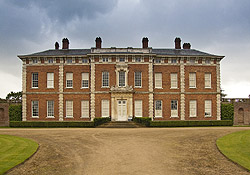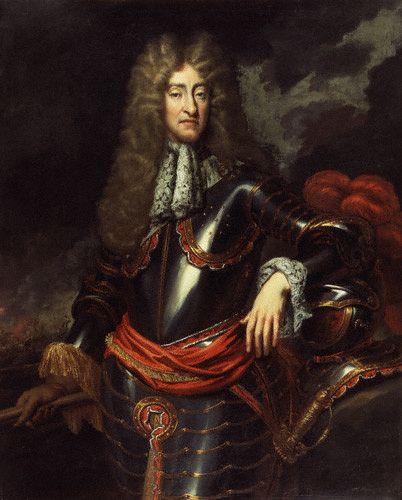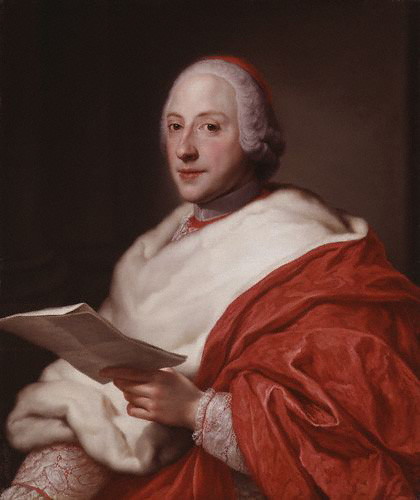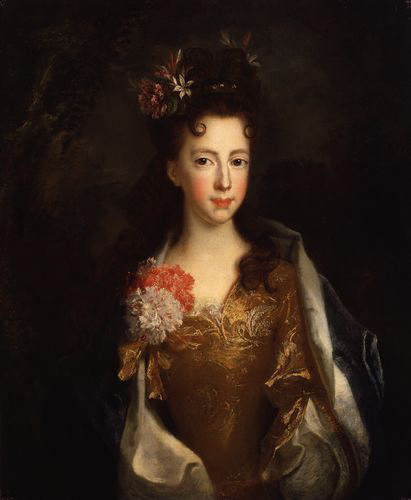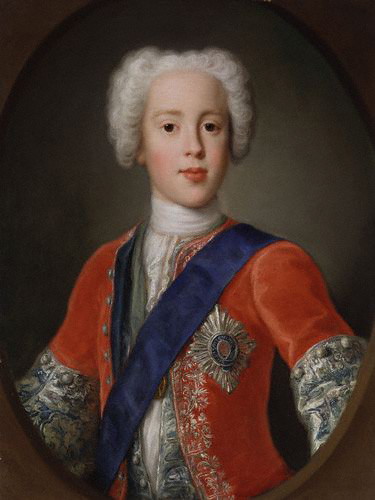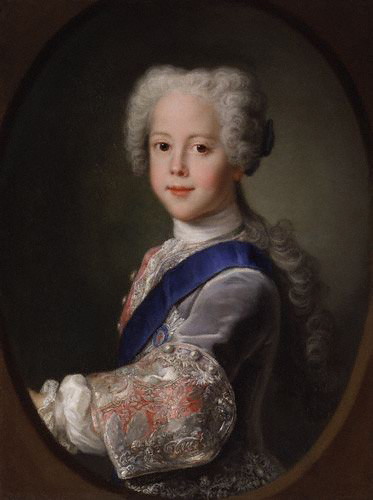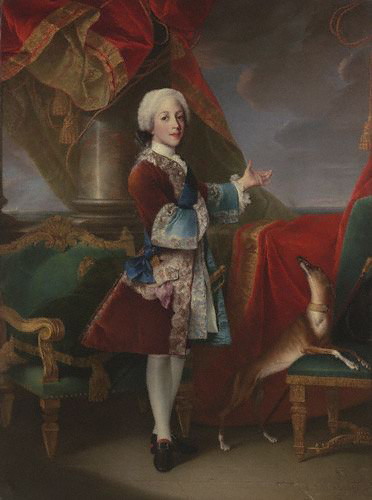 |
 |
 |
 |
 |
 |
 |
 |
 |
A Jacobite Gazetteer - EnglandBeningbrough Hall |
Beningbrough Hall is located ten kilometres north-west of the city of York. In 1958 the house was acquired by the National Trust. Since 1979 it has housed late-seventeenth and early-eighteenth century portraits owned by the National Portrait Gallery. Among the portraits are six of members of the Jacobite Royal Family. |
|
On the ground floor of the secondary staircase hangs a portrait of King James II and VII by an unknown artist.1 The painting was purchased by the National Portrait Gallery in 1873. James is shown wearing armour with a red sash around his waist. His arm rests on a visor which is beplumed with red feathers. In his right hand he holds a marshall's baton. In the background is a battle scene. The painting is of particular interest since it dates from about 1690 when James was living in exile.
In the Saloon on the first floor hangs a portrait of Henry, Cardinal Duke of York (later King Henry IX and I) purchased by the National Portrait Gallery in 1861.2 Henry is shown seated dressed in the red watered silk and ermine robes of a cardinal. In his hand he holds a folded sheet of paper with either writing, or perhaps music, on it. For many years this painting was ascribed to Pompeo Batoni. Later this authorship was rejected, and with it also the identification of the sitter as Henry. Bendor Grosvenor has more recently shown that the original identification of the sitter is sound, particularly in light of the similarity of the likeness to the pastel of Henry by Maurice Quentin de La Tour (formerly identified as his brother Charles) now in the Scottish National Portrait Gallery.3 The painting is now ascribed to the circle of Anton Raphael Mengs.4
The room immediately next to the Saloon is called Lady Chesterfield's Bedroom. Here hangs a portrait of Princess Louise (youngest daughter of King James II and VII). The work is attributed to Simon-Alexis Belle and was painted about 1704.5 The painting was given to the National Portrait Gallery by George Harland Peck in 1912; a virtually identical version of the painting is owned by the Scottish National Portrait Gallery. Louise wears a gold brocade dress with a white and a red carnation. In her hair are diamonds and further flowers.
The next room is called Lady Chesterfield's Dressing Room. Here hang matching portraits of Charles, Prince of Wales, and Henry, Duke of York, both from the studio of Antonio David.6 They were purchased by the National Portrait Gallery in 1876. The first versions of these portraits were painted by David in 1729. Over the next three years he, his assistants, and Alexis-Simon Belle made a number of copies.7 The versions in the Scottish National Portrait Gallery are slightly larger. Charles is shown dressed in a red coat embroidered with silver braid along the buttons, button-holes, and cuffs. He wears the blue sash and the star of the Order of the Garter. Around his neck he wears the green ribbon of the Order of the Thistle; the insignia of the order can be seen under (and partially obscured by) the Garter sash.
Henry is shown facing to the front, but with his body in profile. He wears a grey-blue coat embroidered with silver braid expecially on the cuffs. He wears the blue sash and the star of the Order of the Garter.
On the second floor landing of the secondary staircase is a magnificent portrait of Henry, Duke of York (later King Henry IX and I) painted by Louis Gabriel Blanchet in 1738 when Henry was aged thirteen.8 Its pendant, a portrait of Charles, Prince of Wales (later King Charles III) hangs in the National Portrait Gallery in London. The full-length portrait shows Henry standing in a maroon coat and wearing the sash of the Most Noble Order of the Garter. With his left hand he points towards the background which shows the white cliffs of Dover. To Henry's left is a dog (probably a greyhound) with a gold collar on which is engraved, "Io sono di S.A.R. il Duca di York" (I belong to H.R.H. The Duke of York).
The house also contains numerous other portraits of interest to Jacobites. In the Hall are portraits of Princess Anne (daughter of James II) with her son William, her husband Prince George of Denmark, the Elector Georg I of Hanover, the Elector Georg II of Hanover, the Electoral Prince Friedrich of Hanover, and his wife Augusta. Also here are portraits of James II's faithless commander-in-chief John Churchill (called "Duke of Marlborough") and of the Whig leader William Russell, 5th Earl of Bedford (called "Duke of Bedford"). In the Dining Room hang fourteen portraits by Godfrey Kneller of members of the Whig Kit-Cat Club. In the State Bedchamber hangs a portrait of James II's poet laureate John Dryden. In the Smoking Room hangs a portrait of William III, Prince of Orange, on horseback, and a group portrait of the seven bishops who were committed to the Tower in 1688. On the second floor are four portraits of Prince Wilhelm August of Hannover (called "Duke of Cumberland"). Notes 1The oil on canvas portrait measures 121 cm high by 98 cm wide. 2The oil on canvas portrait measures 78 cm high by 62 cm wide. 3Bendor Grosvenor, "The Restoration of King Henry IX: Identifying Henry Stuart, Cardinal York", The British Art Journal 9 (2008): 32. 4 Anton Raphael Mengs was born at Usti in Bohemia in 1728, and died at Rome in 1779. He painted portraits of Pope Clement XIII, several cardinals, and numerous princes. He also painted portraits and other paintings for a number of Englishmen and Scotsmen, cf. Steffi Roettgen, Anton Raphael Mengs, 1728-1779, and his British Patrons (London: Zwemmer, 1993). There is a pastel portrait of Henry by Mengs now in the Musée Fabre in Montpellier.5The oil on canvas portrait measures 75 cm high by 62 cm wide. Alexis-Simon Belle was born in Paris in 1674, and died in the same city in 1734. In spite of the fact that he won the Prix de Rome, he chose not to train at Rome but rather to remain in France. In 1701 he moved to Saint-Germain-en-Laye where he worked for the English and Scottish court. He painted at least three portraits of Princess Louise, including one now at Sizergh Castle. He also painted portraits of her parents and of her brother James (now at the Hotel Charost in Paris, the Scots Collegein Paris, the Oratorio di San Giuseppe in Urbino, the Palazzo Doria Pamphilj in Rome, and in Pesaro). 6The oil on canvas portraits are slightly different in size. The portrait of Charles measures 64 cm high by 48 cm wide. The portrait of Henry measures 66 cm by 50 cm wide. David was born in Venice. Between 1717 and 1735 he painted over a dozen portraits of King James III and VIII, Queen Clementina, and their sons, as well as several other portraits of members of the Jacobite court in Rome. 7Edward Corp, The King Over the Water: Portraits of the Stuarts in Exile after 1689 (Edinburgh: Scottish National Portrait Gallery, 2001), 67; Robin Nicholson, Bonnie Prince Charlie and the Making of a Myth: A Study in Portraiture, 1720-1892 (Lewisburg: Bucknell University Press, 2002), 42-43. 8The oil on canvas portrait measures 189 cm high by 140 cm wide. Louis Gabriel Blanchet was born in Paris in 1705, and died in Rome in 1772. In 1727 he won second place in the Prix de Rome. Between 1737 and 1748 he painted at least six portraits for the Stuart court. This page is maintained by Noel S. McFerran (noel.mcferran@rogers.com) and was last updated June 27, 2010. © Noel S. McFerran 2010. |
